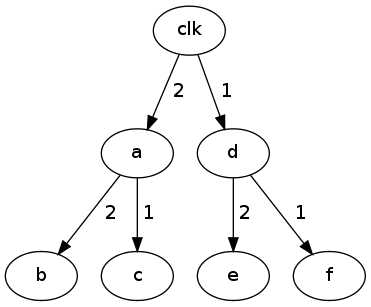- Problem 3 from tutorial 5, if it hasn’t been discussed last week.
- Timing circuits are a crucial component of VLSI chips. Here is a simple model of such a timing circuit. Consider a complete balanced binary tree with n leaves, where n is a power of 2. Each edge e of the tree has an associated length l(e) which is a positive integer. The distance from the root to the given leaf is the sum of the lengths of all the edges on the path from the root to the leaf.The root generates a clock signal that is propagated along the edges to the leaves. We will assume that the time it takes for the signal to reach a given leaf is proportional to the distance from the root to the leaf. For instance, in the following tree, the clock signal will take 4 units of time to reach node b, but only 2 units of time to reach f.

- Consider the following algorithm:
For each level i of the VLSI (where level 0 contains the root): Find the maximum edge weight w among all edges between level i and i+1 Set all edge weights between level i and i + 1 to be w.Give an example to show that this algorithm does not necessarily give a VLSI tree of minimum total edge weights.
- Now give an algorithm that increases the lengths of certain edges so that the resulting tree has zero skew, and the total edge length is as small as possible. For instance, the unique solution for the tree in the figure would be to take the three length 1 edges and increase each of their lengths to 2. The resulting tree has zero skew, and the total edge length is 12, the smallest possible.
- Consider the following algorithm:
- [If time permits] Alice wants to throw a party and is deciding whom to call. She has n people to choose from, and she has made up a list of which pairs of these people know each other. She wants to pick as many people as possible, subject to two constraints: at the party, each person should have at least five other people whom they know and five other people whom they don’t know.Give a greedy algorithm that takes as input the list of n people and the list of pairs who know each other and outputs the best choice of party invitees. If there is no subset that satisfies the conditions, then your algorithm should return the empty set. Do NOT attempt to draw examples, as even small examples have too many vertices. Instead, try to identify people who should not be invited.